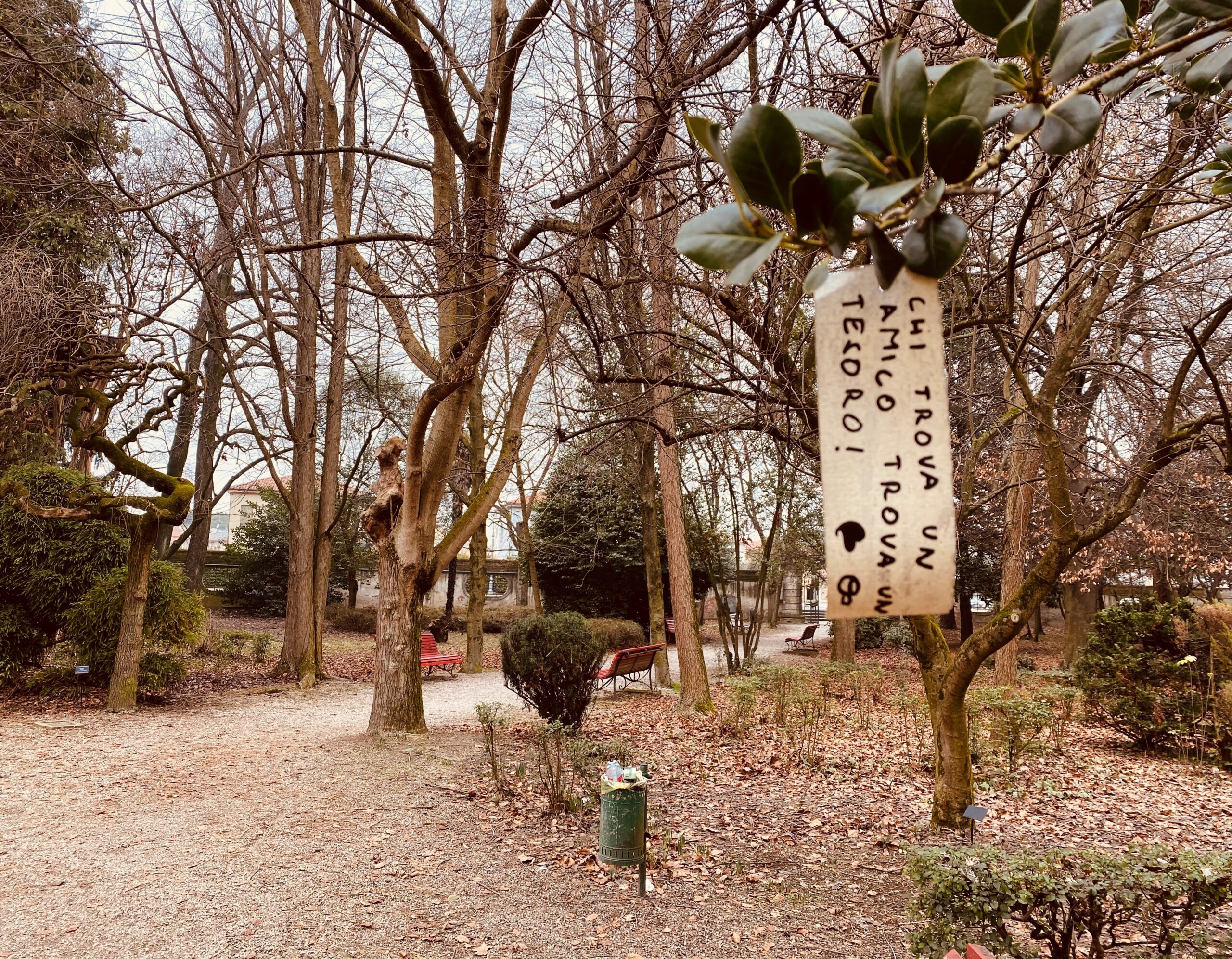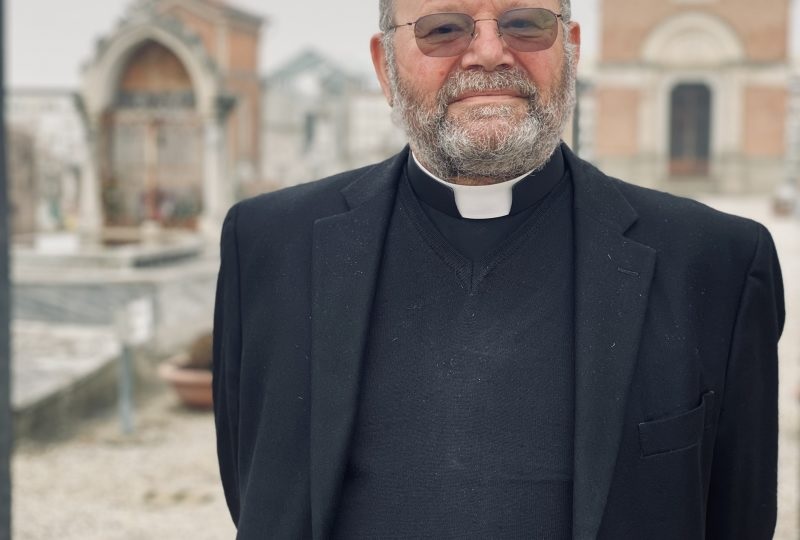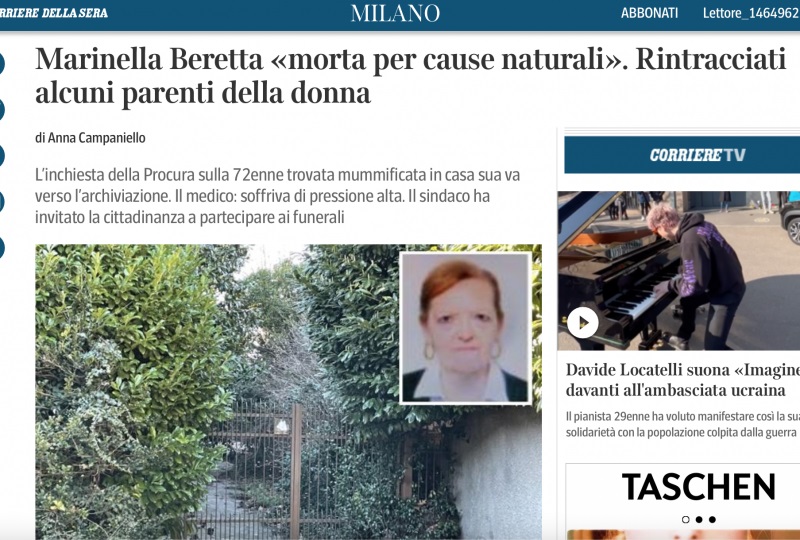
They live among us like ghosts. They die alone like stray dogs. In Japan they are called kodokushi: “lonely death”. In Italy this same phenomenon – people dying on their own at home and remaining undiscovered for a long period of time – happens regularly, but has no name. Nobody doesn’t even count the bodies: not the ministry of Health nor the ministry of Justice or any other national body.
Ignored when they were alive, these dead don’t even become numbers for statistics. However, their stories are not a sort of tragic exception: an epidemic of loneliness has spread all over Italy in the last decades. And Covid restrictions have made the problem even worse.
For Italian mass media, people dying on their own at home are worth what they are worth: usually just a handful of words plus an ID photo on a local newspaper. There are exceptions, though: for example, if the dead is really really dead. If we are talking about months or even better years – like poor Marinella Beretta whose body was found earlier this year, in her home, in Como – then of course it’s different. Big newspapers, like Corriere della Sera or Repubblica, could step in and send someone chasing neighbours whispering a moved «we are so sorry» or saying an «unfortunately the dear departed did like to stay alone» while shrugging their shoulders. Maybe, on top of that, a big writer could be asked a well worded comment to point out that – damn! – nowadays not even death is as good as it once was.
A bit of outrage. A good sprinkle of tears. Amen.
But how many people die alone every year in Italy?
That’s the question that crosses my mind while I read Marinella Beretta’s story for the umpteenth time. In Japan – where this phenomenon is called “kodokushi”[1] and was first described in the Eighties – it’s deemed that the cases of “lonely death” (that’s the meaning of kodokushi) are around 30.000[2] per year. But what about my country, Italy? I send an email to the ministry of Health. As a result, their press office suggests I should try with the National Institute of Health that tells me to have a go with the National Institute of Statistics that recommends sending another email to the Ministry of Justice that finally answers me wishing me a «good day» but «as for your request we are sorry to communicate we do not have the data your are looking for. With regard».
With regard, all right.
But I wonder: how can we deal with a problem if we don’t even know its size? Covid restrictions and the hammering “stay at home” campaign could have multiplied the number of Italian kodokushi creating a true emergency. But how are we supposed to know? Besides, what exactly are these people dying from? Is there some sort of loneliness syndrome? But again: how can we come to any conclusion without a single number?
In the meanwhile, I phone don Dino Pistolato

Mira, the city centre
I stare at his number for a second. I just have to press the green icon on my phone, but I’m hesitating. Same old story for me: each and every time I knock on the door of somebody else’s life, I struggle to get over my embarrassment. It’s part of my job and I’ve been doing this for year, but still I can’t help it: I feel unease; I feel like I’m sneaking into memories and emotions that don’t really belong to me. This will never change, I’m afraid. Luckily for me, Don Pistolato immediately understands what I want to talk about. «Marinella Beretta, that woman in Como? Yes. I’ve heard of her…». Don Pistolato also gets straight away the reason why I want to talk to him.
He’s the pastor at Saint John parish, in Mira, a small town, 38.000 inhabitants, South of Venice. This piece of Northen Italy is as famous for its lagoon and gondole as it is for its wealth. Here, there were – and still are – some of the most amazing villas that the famous Renaissance architect Andrea Palladio built for his rich clients, the Venetian patrizi who wanted a residence in the countryside. Here – nowadays – besides the villas, there’s plenty of more basic detached houses: two stores, a garden and a fence to keep the rest of the world outside. Here the Brenta, a placid river, just two meters deep, crosses slowly fields and towns and throws itself into the shallow Venice lagoon. Here loneliness is a as profound as the ocean.
In the last six months of 2021, six people died alone in their home: their bodies were uncovered days, sometimes even weeks later[3]. Don Pistolato has decided to try to do something: he has created a sort of anti-loneliness team. «We are trying to raise awareness around the problem with some volunteers from our parish charity group». That is to say? «We urge people to get to know who their neighbours are and to keep an eye on them. We did something also in the past, but we are trying to do more. Unfortunately, there’s a disease, the disease of indifference, that for many is a sort of self defense mechanism: the less I know, the better I feel. But can I say something?». Sure. «This phenomenon is not new. It’s just gone unnoticed so far. It’s a long story. For instance, I do remember that 40 years ago, in Trieste, eight people were found dead in their home. Eight in one single day…».
The tale of two brothers
Exactly in Mira – some years ago – there was another case of kodokushi that left this quiet town in disbelief. It was May 2015. A weird smell and a swarm of flies – according to the newspapers’ reconstruction of the events[4] – were coming out from the door of a flat. At first, neighbours didn’t notice it, then they get annoyed, finally they started to worry. Somebody took the phone. Police and firefighters knocked on the door and then knocked it down. What they saw was something astonishing even for people, like them, trained and prepared for anything: it was spring, but the corpses of Emanuele e Mauro Gallina, 43 and 41 years old, were still wearing winter clothes. In the house – a council house – there was no running water and no electricity. There was nothing. Even the cupboard in the kitchen: empty. It wasn’t suicide. It wasn’t murder. So what did they die from? Hunger? Cold? Or what?
The two brothers were both unemployed and everybody knew that. And everybody knew as well that often they had to go to the canteen of Caritas, a catholic charity, to have something to eat. When they stopped to go out even for food, the vox populi was they moved to Germany looking for bread and jobs. It never happened. They never left their flat, but they became sort of invisible for everybody else.
Their dad had taken his life many years before. Mom too passed away in 2012. Since then, Emanuele and Marco had become more and more isolated, lost in a whirlpool of pain that one day made them disappear. They started living like ghosts, though they were alive. Then they became ghosts – and that was it.
Becoming invisible

Don Dino Pistolato
I remind Don Pistolato of this story when we meet in his living room, few steps from the church and the cemetery of his parish. I repeat precisely this word: ghosts. He nods: «Last year I celebrated one of the funerals of those who died alone and I said it out loud: for you, even before the bodies were found, those people were already dead: not physically, but in your memory, in your mind, they had already ceased to exist, you couldn’t see them anymore». Precisely as if they were transparent.
But how does a person become invisible? Those six people in Mira had had different lives: they were pensioners, farmers, blue collar workers, housewives. Some of them were old, but others were still in their forties. However, they all had one thing in common a part from living alone: they didn’t have a job. Nobody noticed they were missing, because they didn’t have to sign in and out at their workplace. They weren’t – or they ceased to be – part of the big factory that the world has become. Without them, the machine will work just fine.
«Mira is so small that we all know everything about everyone else, even too much. But sometimes other people’s lives become sort of less interesting, and then this lack of interest can turn into oblivion. This happens when people become less active, less efficient. Till you are part of the system, it’s all right. But when you are not, when you need help, you become a problem: that’s the moment when you are left alone or if you are really old, maybe, you are sent to a care house. And people just forget about you…», says Don Pistolato. Then he adds something that really takes me aback: «However, the problem is not that there are a few cases of people dying alone. The problem is that, here, there are hundreds of people that, though they still walk and talk, are like dead, because they don’t have any relationship with anybody else. Some of them give me a ring, every now and then, you know?». And what do they say? «Hello Don Dino, can we have a chat? And sometimes I go and visit them. Look: if a person was already dead before his or her death, you can get it straight away at the funeral. If there are only relatives attending the ceremony, well, that’s the case: they were probably already dead. This year, so far, I celebrated 96 funerals. The ghosts? Half of them. Yes, I’d say 50%. No doubt about it», says Don Pistolato, stressing each word: «No-doubt-about-it». «But Mira – he points out – in fact is not the worst place on earth, at all. However, pandemic had a big impact here. Elderly people were afraid to go out and younger relatives too were pushing them sto stay at home not to get infected. The problem existed before, sure. But the restrictions have made it bigger and therefore, in a way, easier to see».
Solitude on the rise
Don Pistolato, during our one-hour-long conversation, repeats several time that, in the end, the big issue is the quality of human relationships, that are getting weaker and weaker, when they even exist. In one word: solitude. And solitude in Italy is growing at astonishing pace. A quick look at the Italian National Institute of Statistics database[5] clearly shows what is going on. In 1998, people living alone in Italy were 4.6 million. In 2010, 7 million. Nowadays, the latest figures show they are 8.5 million. These “loners” are mainly elderly: one in two is over 65. Women are more than men: nearly 5 million.
The Italian National Institute of Statistics explains the situation in this way[6]: these are the «consequences of long-term socio-demographic dynamics: the aging of the population; the increase in marital instability; the low birth rate. The increase in life expectancy generates a greater number of lonely people. The decline in the birth rate increases the number of people without children while the rise in marital instability increases the number of people living alone and of single parents following the dissolution of a couple».
To put it in more simple terms: if you add up less marriages and less children with more divorces and more aging the result is this: more solitude. And if nothing changes, the Italian National Institute of Statistics forecasts, that in 2040 the number of people living alone – by choice or by necessity – is going through the roof: they’ll be more than 10 million, one sixth of the entire Italian population.
Number one in Europe

“Cursed Solitude” book cover by Marco Trabucchi e Diego De Leo
But there’s a “but”. Living alone and feeling lonely are different things. Unfortunately, numbers tell us that in Italy the latter – call it isolation, loneliness or, as we said before, solitude – is a big problem too. A few years ago, Eurostat, the European Institute of Statistics, carried out a survey that made headlines in the Italian press[7]. The data, that were collected in 2015, showed that more than one Italian in ten (13%) couldn’t think of anybody to ask for help: not a relative, a friend or a neighbour. According to this survey, Italy was, so to speak, top of the class in Europe: nobody made worst than that as the European average was just 5.9 %. Moreover, according to the same Eurostat survey, Italy was also the country that had the biggest percentage of people who didn’t have anyone to discuss personal matters: 12,4% compared to a European average of 6%.
The other epidemic
Psychiatrists Diego De Leo e Marco Trabucchi, in an essay published just before the beginning of the Covid19 pandemic, wrote that these Eurostat numbers about loneliness entirely tore apart «the cliché (…) that Italians are really extrovert and outgoing» and that Italy is «the country of volemose bene and a certain “touch culture”». Their book, “Cursed Solitude”, puts together hundreds of data and studies to show how another pandemic has been spreading and not only in Italy: solitude. De Leo and Trabucchi quote, for example, the case of the Uk that has created a Loneliness ministry and recall that the US too, like all major European countries, have had to deal with this problem in the last years. No Western country, not even China is immune from this evil.
In their essay, De Leo and Trabucchi also write about people dying at home and remaining undiscovered for a long period of time. A passage about Spain in particular catches my attention: «In the first four months of 2010, in Madrid, more than a hundred people died completely alone in their flats». The two psychiatrists mention Japan as well, but say little about Italian kodokushi. I try to get in touch with them to understand why.
Trabucchi – a University professor; a CV longer than the Encyclopedia Britannica – is really kind, but clear as a sunny day: «We just don’t have numbers about this phenomenon in Italy», he says on the phone, while working in his office in Brescia, where he is head of a geriatric research group. But shouldn’t we study this issue? «We don’t have to blame politicians for this. It’s our fault: university professors and big research centers haven’t worked on it», he answers frankly. «However – Trabucchi points out – this is not a quantitative problem, it’s a qualitative one. If we really care about fragile people, it doesn’t really matter if it’s just one person or a hundred. But sure if numbers are big, the effort we must put to cope with the problem must be bigger too…».
Marinella and the others

Two years: that’s how long Marinella Beretta had been waiting for before someone finally arrived and took care of her mummified body[8], still seated at her table in the kitchen, in Como. Her lonely death made big headlines on Italian mass media. However, other similar stories happen regularly in Italy, they just go nearly unnoticed. Sure, most of the times, corpses are uncovered after days or weeks, not years, but the dynamic is basically the same: a man or a woman, often elderly people, die alone at home and nobody – friends, relatives or neighbours – noticed they ceased to exist for a while.
It happened once again just a few days ago in Palermo[9], Trieste[10] and Lodi[11]. In these three cases too, the events unfolded following a very well known pattern: somebody, usually the neighbours, eventually raised the alarm; police and ambulances arrived when it was already far too late. The three victims, all male, were 50, 70 and 62. Their bodies were all uncovered several days after the demise. Just googling and focusing on the last two years and a half, that is to say Covid19 pandemic period, I could find dozens and dozens of cases of kodukoshi in Italy.
The most atrocious episode dates back to September 2021. In Borgo Santa Croce – a handful of houses not far from the town of Macerata[12], Center of Italy – somebody finally knocked on the door of a detached house that hadn’t opened for months. Inside three bodies lay lifeless: Eros Canullo, 80 years old; Alessandro, his severely disabled son; and mamma Angela Maria, disabled too and unable to move from her bed, as a consequence of an illness. The reconstruction of events that led to their death made by the forensic team is simply appalling: mr Canullo, who would take care of the rest of the family, had a stroke and fell on the floor, powerless. Mother and son, unable to take care of themselves, couldn’t even ask for help. Canullo died as a consequence of the stroke. Mother and son probably died of hunger.
«Like we did for Covid19 and unvaccinated people…»
The ways mass media describe stories like these is often full of stereotypes. Who dies alone in most cases is described as a person who really would love to stay on his own. In fact – as De Leo and Trabucchi explains in “Cursed solitude” – this is not true. These extreme forms of solitude aren’t really a choice.On the contrary they often arrive as a result of a deep psychological unease. Loneliness can become like a cage that people can’t escape and loners are ashamed to admit that they suffer from this condition: they are afraid to be deemed as weird, they fear some stigma. Besides loneliness produces loneliness in a sort of vicious circle: who is often alone is kind of dumber in social interactions and so the others tend to marginalize him. Another journalistic cliché is the question: how come nobody realized the dead was dead? Shouldn’t he or she pay their bills slash pay their rent slash do something else? But professor Trabucchi argues this is not the point: «We kind of went hunting down unvaccinated people during the pandemic, because, we said it was dangerous for them. We should do the same thing for people who suffer from extreme solitude, because this condition is dangerous too for their future».
As lethal as smoking
Health risks of prolonged isolation, when it’s not a choice, are equivalent to «obesity or to smoking 15 cigarettes a day», wrote De Leo and Trabucchi in their book. Several studies show that it disturbs sleep and that it can be linked to to poorer cognitive function and higher risk for dementia, and that it also increases the risk of heart diseases and strokes. Moreover, lonely people take often little care of themselves: they go to the doctor less and eat badly. Having read all this, I have a question to ask the authors of “Cursed solitude”: do kodokushi actually die from loneliness? «Sure – answers professor Trabucchi -. There’s a biological cause, but» often their demise comes as «direct consequence of solitude».
Stay at home, but not too much
These last two and half years of pandemic and the hammering campaigns to promote social distancing haven’t really helped. «Calls to stay home – argues professor Trabucchi – have become a sort of mantra, we’ve been exaggerating. We should have taken into account that there are so many damages and risks linked to loneliness, that it would have been worth running some risks». But what is done cannot be undone. What about the future, then? «This topic doesn’t really “heat” politicians, because politics nowadays is not about people’s real problems; it’s all about interests. But the point is we need a society which is fairer, a society based on “us” not just “me”, a society curious about the others. Till this change doesn’t happen, politics can do little». In sum, it’s on us. Is it the kodokushi one, the brave new world we want for our future?
[1] https://it.wikipedia.org/wiki/Kodokushi
[2] https://www.nippon.com/en/in-depth/d00736/
[3] https://nuovavenezia.gelocal.it/venezia/cronaca/2021/12/06/news/morto-in-casa-trovato-dopo-una-settimana-e-il-sesto-caso-a-mira-da-fine-maggio-1.41001247
[4]https://necrologie.mattinopadova.gelocal.it/news/10277
[5] http://dati.istat.it/Index.aspx?QueryId=17768#
[6] https://www.istat.it/it/files/2021/11/REPORT-PREVISIONI-DEMOGRAFICHE.pdf
[7] https://ec.europa.eu/eurostat/statistics-explained/index.php?title=Social_participation_and_integration_statistics#Formal_and_informal_voluntary_activitiesNetherlands and Finland (6.6 percentage points (pp) for France, 3.7 pp for the Netherlands and 2.8 for Finland).
[8] https://milano.corriere.it/notizie/lombardia/22_febbraio_12/marinella-beretta-morta-cause-naturali-rintracciati-alcuni-parenti-donna-7978055e-8bd6-11ec-a14e-5fea75909720.shtml
[9] https://www.blogsicilia.it/palermo/morto-casa-vicini-puzza-via-porta-castro-ballaro/791483/
[10] https://www.ilgazzettino.it/nordest/treviso/morto_casa_solitudine_anziano_ritrovato_decomposizione_ecco_chi_e_e_cos_e_successo-6999509.html
[11] https://www.ilgiorno.it/lodi/cronaca/uomo-morto-in-casa-1.8193671
[12] https://www.cronachemaceratesi.it/2022/05/04/la-verita-sulla-tragedia-dei-canullo-eros-colpito-da-un-malore-moglie-e-figlio-morti-dinedia/1635996/
Leave a Reply